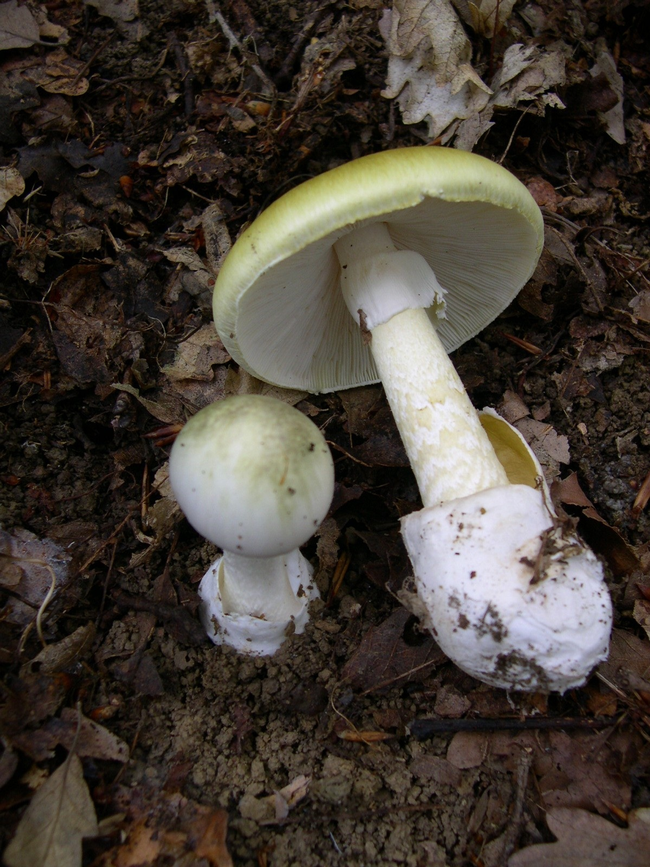The atmospheric river event in October of 2021 followed by mild temperatures in northern California turned many grasslands green but may have also resulted in advantageous growing conditions for many types of mushrooms. Different species of mushrooms have a particular growing season between fall and spring, but overall, they require moisture to grow, which we now finally have. If you encounter lots of mushrooms where cattle graze, you may wonder whether they can pose a danger to your livestock. As with many other poisonous plants (although mushrooms are technically not plants), cattle will avoid them if other food sources are available, but occasional accidental ingestions can occur, and it doesn't take much to cause problems.
There have been two documented cases of mushroom poisoning in beef calves in California a few years back in 2008 and 2009. In both calves that died from mushroom poisoning, amanitin, the toxic substance that is found in three different genera of mushrooms Amanita, Galerina, and Lepiota, was detected. The calves were from Sonoma and Napa counties and both were found dead without any previous signs of illness.
The most common species of amanita containing poisonous mushrooms along the West Coast are Amanita phalloides (Death Cap) and Amanita ocreata (Destroying Angel). Death Cap is common in the San Francisco Bay area and along the Pacific Coast and is abundant in warm, wet years. It is found close to oak, birch, and pine trees, but can also be found in open pastures in the Central Valley. The Destroying Angel occurs all the way from Baja California along the Pacific coast to Washington and is commonly found in the foothills and valley floor of California's Central Valley.
Poisonings from amanitin have also occurred in people, dogs, and horses. The poison is extremely potent, and one or two Death Caps could kill an adult cow or horse. The toxic mechanism for amatoxins is the blocking of RNA polymerase, an enzyme necessary for producing messenger RNA, ultimately required for protein synthesis. Liver and kidney cells have a high metabolic rate and are particularly vulnerable to this toxin, which leads to necrosis in
these organs. Liver necrosis was noted on both calves that fell victim to the poisonous mushroom
ingestion, which is a typical finding also in blue-green algae poisoning, cocklebur ingestion, or
copper toxicosis.
What should you do if you suspect poisonous mushroom growing in your fields?
There are field guides that can help identify mushrooms, but this is not a trivial endeavor. Many mushrooms look very similar to each other so making an identification based on an online photo is difficult. Local mycologists or mushroom hunters may be able to help. Another idea is to use a phone app called iNaturalist where users upload pictures of organisms and other users, many of whom are scientists, help identify them. The app is a joint initiative of the California Academy of Sciences and the National Geographic Society where all users may help contribute to the identification of uploaded plants, animals, or fungi. There is no guarantee that the app will provide an accurate identification, but it will allow the user access to many enthusiasts and professional botanists and zoologists and certainly presents an improvement over using a picture guide. Finally, there is a test kit available that identifies amatoxins in small amounts of mushroom tissue or urine of an animal that is suspected of having consumed the poisonous mushrooms. The test is less sensitive than lab testing at CAHFS, so negative results have a chance to be false. The kit was developed by the USDA Agricultural Research Service and costs $45 for 3 tests or $205 for 15 tests. Unfortunately, due to high demand, the kits are sold out at the moment, but should be available again in early 2022 from this site: https://amatoxtest.com/. If the mushrooms you found are identified as poisonous, it is best to pull them out and discard them. To avoid any contact with the mushrooms, wear gloves and wash your hands after
handling them.
What should you do if you suspect mushroom poisoning in cattle?
As always when encountering sudden death in livestock, contact your veterinarian to discuss the case and get help with identifying the cause. There are many causes of sudden death in cattle and a good history combined with a field necropsy is the best strategy to get to the bottom of it. If no obvious cause can be found and you have observed mushrooms where the animal was grazing, collect some of them and submit together with the carcass or tissues to the diagnostic lab. Taking a close-up focused picture of the mushrooms may also be helpful in making a diagnosis. Toxicological tests are necessary to confirm a diagnosis and the best tissues to submit are rumen content, liver, kidney, and urine. However, to be able to rule out other causes, additional tissues or the entire carcass should be submitted.
Unfortunately, there are no specific treatments or antidotes for these types of poisonings.
Supportive care to help an animal clear the toxin from its system is all that can be done for
surviving animals with suspected mushroom poisoning.
The chances of mushroom poisonings in cattle are certainly slim, but they should be on your
radar if nothing else seems to make sense, especially when conditions are right for mushrooms to grow.

Amanita phalloides (Death Cap)
Credit: Archenzo, CC BY-SA 3.0 http://creativecommons.org/licenses/by-sa/3.0 via Wikimedia Commons